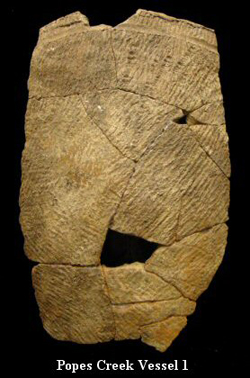Popes Creek Pottery Vessels
December 2008
By Edward Chaney, MAC Lab Deputy Director
 In the fall of 2006, an avocational paleontologist, Brady Hamilton, decided to spend a day walking along the shores of the Potomac River in Charles County, looking for specimens to collect. He came upon an area where oyster shells from a prehistoric Indian trash midden were eroding down onto the beach. Among the shells were large sherds of Indian pottery. He gathered them up and took them home, where he was able to piece together large sections of two different vessels. Mr. Hamilton then contacted local archaeologists about his find, and generously agreed to donate his artifacts to the Maryland Archaeological Conservation Laboratory.
In the fall of 2006, an avocational paleontologist, Brady Hamilton, decided to spend a day walking along the shores of the Potomac River in Charles County, looking for specimens to collect. He came upon an area where oyster shells from a prehistoric Indian trash midden were eroding down onto the beach. Among the shells were large sherds of Indian pottery. He gathered them up and took them home, where he was able to piece together large sections of two different vessels. Mr. Hamilton then contacted local archaeologists about his find, and generously agreed to donate his artifacts to the Maryland Archaeological Conservation Laboratory.
Archaeologists were eager to accept his donation, because it is rare to find large portions of this particular type of Indian pottery -- known as Popes Creek Ware -- which was made from roughly 500 B.C. to 300 A.D. The clay of Popes Creek vessels was generally mixed with lots of sand, and the pots fired at a low temperature. This meant that they were somewhat fragile, so intact examples are extremely uncommon. Even finding enough sherds to partially reconstruct a Popes Creek vessel, as Mr. Hamilton did, is unusual.
The most complete of the two vessels found by Mr. Hamilton would have been about 16 inches in diameter when it was intact. Its height is unknown, since only the upper portion (15 inches) of the pot was recovered. The vessel was cylindrical in shape, and probably tapered to a conical or semi-conical base, which was typical on Popes Creek Ware. The exterior surface of the pot was covered with impressions of cords that were stamped vertically or diagonally to the rim. The interior surface was scored with fine smoothing lines, most running horizontally, although some were vertical or diagonal to the rim. This vessel was unusual for Popes Creek Ware because it was decorated: a finger-smoothed band ran approximately one inch below the rim, and the lip of the pot had shallow notches impressed into it.
 |

|
 The second vessel was less complete, but appears to have been larger, perhaps 18 inches or more in diameter. Unlike the first pot, its exterior was covered with the impression of a net that was pressed
against the clay before it was fired. The majority of Popes Creek vessels had a net-impressed surface; the cord-marking seen on the first pot was less common. The interior surface of the second vessel
was scraped like the first, but the orientation of the lines was more haphazard. It too had a finger-smoothed decorative band just below the rim, and fine lines were scratched into the lip.
The second vessel was less complete, but appears to have been larger, perhaps 18 inches or more in diameter. Unlike the first pot, its exterior was covered with the impression of a net that was pressed
against the clay before it was fired. The majority of Popes Creek vessels had a net-impressed surface; the cord-marking seen on the first pot was less common. The interior surface of the second vessel
was scraped like the first, but the orientation of the lines was more haphazard. It too had a finger-smoothed decorative band just below the rim, and fine lines were scratched into the lip.
Finding a large portion of a Popes Creek vessel is unusual; finding two such pots at the same time is remarkable; finding two decorated examples is practically unheard of. Brady Hamilton’s foresight and
generosity has resulted in a special addition to Maryland’s archaeological collection, which is why it is this month's Curator's Choice selection.
For more information, go to:
http://www.jefpat.org/diagnostic/PrehistoricCeramics/Prehistoric%20Ware/>%20Descriptions/PopesCreek.htm